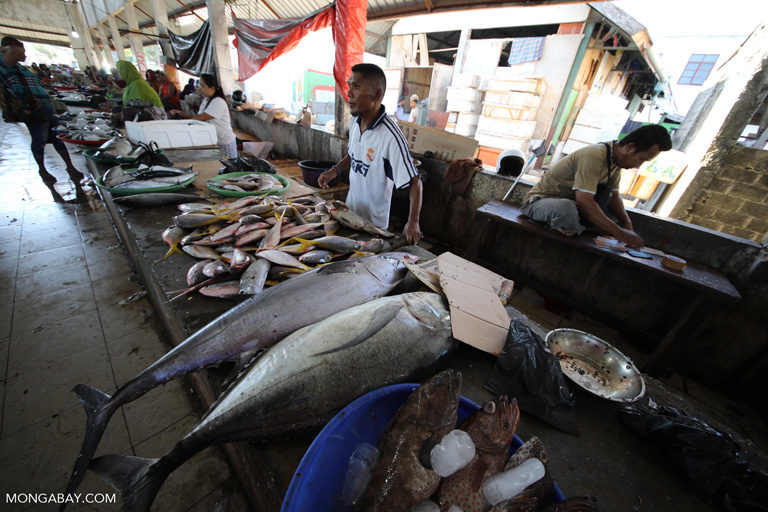- The Indonesian fisheries ministry is implementing a new scheme under which operators of large fishing boats would pay a range of fees after landing their catch instead of before.
- The ministry says the change is meant to boost state revenue from these non-tax fees, but observers warn it opens the potential for an increase in unreported catches.
- That’s because a key feature of the new policy is that it relies heavily on self-declarations by fishing boat operators when reporting the volume of their catch at port.
- Indonesia has one of the biggest fishing industries in the world, employing about 12 million mostly artisanal fishers, and its waters support some of the planet’s highest levels of marine biodiversity.
JAKARTA — Marine observers in Indonesia have warned of a potential rise in illegal and unreported fishing in the wake of a new policy for how the government collects revenue from big fishing boats.
This non-tax revenue includes fees for certification, resource exploitation, port services, quality inspections, and training, among others. The Indonesian fisheries ministry in 2021 issued a decree that allows operators of fishing vessels larger than 60 gross tonnage to pay all non-tax revenue in a lump sum after they land their catch at port. Previously, they were required to pay before going out to sea, when applying for business and fishing licenses.
The ministry says the main reason for the change is to boost state income from the marine capture fisheries sector, while also tackling illegal practices of marking down boat sizes and overfishing.
“The endgame is actually for Indonesia to have fisheries management system that’s well regulated, reported, and obeyed by all stakeholders,” Sakti Wahyu Trenggono, the fisheries minister, said at a press conference in Jakarta on Feb. 28.

Sakti said that while the new fee scheme wasn’t necessarily designed to crack down on illegal, unreported and unregulated (IUU) fishing, it would target increasing state income that could then be allocated to improve fisheries infrastructure and help boost small-scale and traditional fishers’ welfare.
The government expects to raise 1.63 billion rupiah ($107,000) in non-tax state revenue from the capture fisheries sector in 2023, and up to 1.7 billion rupiah ($111,000) in 2024, according to the fisheries ministry. The ministry’s data showed that the average total catch per year was 7 million metric tons annually over the past five years, valued at up to 140 trillion rupiah ($9.2 billion).
However, some marine observers say the policy will make an insignificant contribution to increasing state revenues, while likely widening the loophole for fishers to misrepresent the actual volume of their catches.
Its main feature is that it relies heavily on self-declarations by fishing boat operators when reporting the volume of their catch at port. This opens the potential for underreporting catch volume in order to reduce the non-tax revenue to be paid. The policy also prioritizes administrative sanctions, such as fines and permit revocation, for violations, while reserving criminal punishment as a last resort.
“Strict law enforcement must be at the forefront for this policy, because otherwise it will easily give people opportunities to do fisheries crimes, especially IUU fishing, especially with such lenient sanctions,” Parid Ridwanuddin, the coastal and marine campaign manager at Walhi, the largest environmental advocacy NGO in Indonesia, told Mongabay in an interview.
He said the 2021 regulation fails to explicitly put the responsibility for ecological stewardship on fishing businesses, and that it will be incumbent on the government to bear the costs for rehabilitation measures later on.

The new scheme is now being implemented at 77 fishing ports, mostly in eastern Indonesia. The ministry says it hopes to apply it nationwide gradually over the next couple of years, adding that 576 fishing businesses have expressed their preparedness to adopt the new fee scheme.
Parid said more work still needs to be done for the policy to work out efficiently and effectively. This includes putting in place the strictest measures for monitoring and law enforcement at the landing ports and at sea.
He added the current law enforcement regime that prioritizes administrative sanctions over criminal punishment is a consequence of the highly controversial 2020 Job Creation Law, which ushered in sweeping deregulation across a wide swath of industries. Parid said he had reviewed from than 100 fisheries crime convictions in 2019, and found that the average administrative and crime sanctions were much weaker than those prescribed by the previous law.
“Now that it’s basically only administrative sanctions, it’s even more dangerous because the law seems to go easy on violations by those who are stealing our resources,” he said. “Just for the purpose of raking in a lot of non-tax state revenue from the fisheries sector, the sanctions are being loosened.”
The fisheries ministry has acknowledged that compliance among fishing companies in Indonesia is low. The ministry has officially registered just 6,000 fishing permits, but the transportation ministry records some 23,000 permitted vessels.
“Honestly, I am pretty upset when we talk about compliance levels in Indonesia,” Sakti said. He added his ministry was beefing up security measures by using satellite vessel monitoring technology and boosting at-sea patrolling efforts.
Regular patrols are costly and limited due to lack of infrastructure and human resources, especially for a massive archipelago like Indonesia with its thousands of islands. The fisheries ministry says it would ideally need at least 78 boats, or more than double what it currently operates, to monitor the country’s waters for illegal and destructive fishers, both foreign and domestic. Other government bodies that patrol Indonesia’s waters, not necessarily for fishing violations, include the Navy, the Coast Guard, and the National Police.
Budget cuts at the fisheries ministry in recent years have also led to a reduction in total patrolling time, according to a report by the Indonesian Traditional Fishermen’s Union (KNTI). The ministry’s patrols dropped to a total of 84 days in 2019, from 270 days in 2015, the group reported.

Indonesia is the second-biggest marine capture producer, after China, harvesting 84.4 million metric tons of seafood in 2018, according to the U.N.’s Food and Agriculture Organization (FAO). The country’s waters support some of the highest levels of marine biodiversity in the world, and the fisheries industry employs about 12 million Indonesians.
Indonesia’s wild capture fisheries employ around 2.7 million workers; the majority of Indonesian fishers are small-scale operators, with vessels smaller than 10 gross tonnage. Under the business-as-usual scenario, capture fisheries is projected to expand at an annual rate of 2.1% from 2012 to 2030.
Government data from the third quarter of 2022 showed that the fisheries sector contributed 2.5% to the country’s GDP, or a value of nearly 6 trillion rupiah ($393 million). However, the non-tax revenue from the fisheries sector in the recent years has failed to meet the government’s targets. Last year, the fisheries ministry recorded 1.2 trillion rupiah ($78.5 million) in non-tax revenue, short of its target of 1.6 trillion rupiah ($104.7 million).
The new fee scheme is one of the first steps toward the implementation of a quota-based fisheries management policy proposed by the ministry. However, many marine observers have spoken out against the new strategy, saying it threatens the sustainability of the country’s fish stocks, especially when more than half of the fisheries management areas are already fully exploited, indicating that more stringent monitoring is required.
“The Indonesian government’s mindset shouldn’t only be about how to exploit the fish resources, which they consider to be less profitable [than land-based resources], but they must prioritize the socioecological aspects as well,” Parid said.

Basten Gokkon is a senior staff writer for Indonesia at Mongabay. Find him on Twitter @bgokkon.
See related from this reporter:
Indonesia to issue quota-based fisheries policy in July, sparking concerns
FEEDBACK: Use this form to send a message to the author of this post. If you want to post a public comment, you can do that at the bottom of the page.







Write a comment
Your email address will not be published. Required fields are marked *